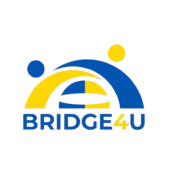About us
" Bridges are not built from steel or stone — they are built from understanding, compassion, and hope."
About the project
The BRIDGE4U project represents a strategic and comprehensive response to the ongoing humanitarian crisis caused by Russia’s war against Ukraine. Since 2022, millions of Ukrainians have sought refuge in EU member states, and while emergency measures have provided essential relief, many refugees still face significant barriers to long-term integration. These challenges include language barriers, lack of recognition of qualifications, difficulty accessing employment and education, and limited familiarity with local institutions and systems. Host communities, too, face pressures in adapting infrastructure, services, and social systems to support large numbers of newcomers effectively.
With a duration of 18 months and a total budget of €646,883, BRIDGE4U operates as an EU-funded transnational initiative bringing together eight partner organizations from different European countries. Its structure reflects a clear and evidence-based understanding of the integration process: that successful integration requires not only resources and services but also trust, empowerment, and community-level cooperation. The project therefore works on multiple levels simultaneously — supporting refugees directly, empowering local actors, and building sustainable systems that can continue beyond the project’s duration.
At the heart of BRIDGE4U is the creation of Guidance Hubs. These are physical or hybrid spaces designed to act as safe, welcoming environments where refugees can receive personalized support. The hubs will provide direct guidance on accessing essential services, legal rights, housing, employment, and educational opportunities. They will also host training sessions to build language skills, vocational skills, and digital literacy, as well as workshops that encourage active participation in community life.
In parallel, the project will produce multilingual integration resources — both printed and digital — to ensure that refugees can easily access reliable information in their own language. These resources will be complemented by a digital platform that acts as a knowledge hub. The platform will centralize tools, guidance, and training modules, making it easier for refugees and practitioners alike to find and use integration resources effectively. By combining on-the-ground support with digital accessibility, BRIDGE4U ensures that no one is excluded because of language, location, or lack of access to formal services.
Another core component of the project is its research and evidence-based methodology. Early in the implementation phase, the consortium will conduct comprehensive community needs assessments and mapping of existing services in each participating country. This research will identify both gaps and opportunities, allowing partners to tailor interventions to local realities. It will also provide valuable data to support policymakers and stakeholders in improving refugee integration strategies.
BRIDGE4U also places a strong emphasis on communication, awareness raising, and community engagement. Integration is a shared process: host societies must also adapt, and communities play a crucial role in making refugees feel welcome and safe. Through awareness campaigns, storytelling, events, and partnerships with local actors, the project aims to build bridges between communities and foster positive narratives around migration and inclusion.
Importantly, BRIDGE4U is designed with long-term sustainability in mind. The Guidance Hubs, digital platform, and training models are developed to be replicable and adaptable. By the end of the project, the consortium will have created a framework that other EU member states can use to strengthen their integration systems for Ukrainian refugees and other displaced populations.
Finally, BRIDGE4U reflects the European Union’s commitment to upholding human dignity, democracy, and inclusion in times of crisis. By equipping both refugees and host communities with the tools, knowledge, and structures they need, the project aims to build a more resilient, cohesive, and compassionate Europe.

